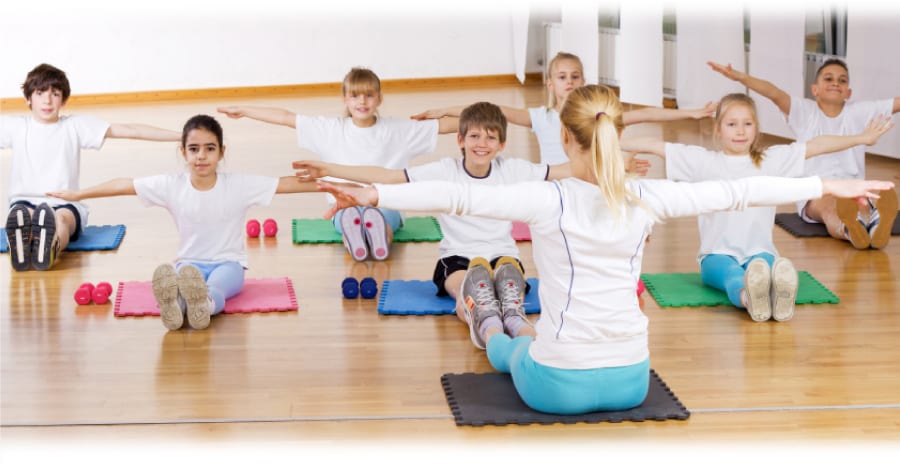With more than 30 million people practicing yoga worldwide, it’s clear that this is no passing trend. People flock to it for all sorts of reasons, and when they find more than they were looking for, they continue on with it. The basics of yoga can be performed anywhere, from in studio to the outdoors or even with an in home personal trainer. The benefits don’t begin at a specific age, though. There are many people who promote yoga as a healthy prenatal activity, which benefits both mother and child. The space between leaving the womb and entering into adulthood shapes an individual’s life. Incorporating yoga into a child’s routine, therefore has incredibly profound effects. Here’s a look at seven ways that yoga is beneficial for children.
- Yoga teaches children to accept and love their bodies. In an era where everyone is a celebrity, and kids are glued to reality TV and YouTube, physical activity is rare. However, these traps that children fall into today leave them heavier than ever, and with low self-esteem. While children in these situations might not be able to keep the pace in a competitive sport, they can excel at yoga, and appreciate the capabilities of their bodies.
- Yoga promotes physical health. Not only does it improve self-esteem, but even children who start out at a disadvantage health-wise begin to see healthier, leaner bodies the more they practice. On top of this, they gain better balance, coordination, strength, and flexibility. This pulls them out of unhealthy cycles. They learn to appreciate what they’re capable of and make improvements, and their bodies improve as well. This encourages them to continue, and a healthy cycle is born.
- Yoga reduces stress and anxiety. Through the regulated breathing required in yoga, children learn how to control their bodies better. This is beneficial when emotions rise, as kids can then call upon their yoga training to calm their body’s reaction during a stressful time.
- Yoga improves optimism. Several studies have shown that people who practice yoga are more optimistic. The benefits already listed here show that overall wellbeing comes into place, which can furthermore help children feel more optimistic, and resilient.
- Yoga helps children become more disciplined. As children become more mindful, and learn the power of intention, they also become less impulsive, have the ability to better-regulate their attention, and have improved patience.
- Yoga helps children focus and perform better in school. Naturally, this mindfulness and balance bodes well academically. Some studies suggest that yoga can help children with ADD and ADHD, as long as they participate at least twice per week.
- Yoga sets children up for a lifetime of health and wellness. Synapse formation in the prefrontal cortex occurs in two major growth spurts during childhood. The first is during infancy, and the second happens around age 11 or 12, just before a child hits puberty. After the second growth spurt, the brain begins to drop unused synaptic connections. Those that are being used are strengthened in return. Giving a child the gift of yoga, and all that comes with it, before this neurologic change occurs, can help a child grow into a well-adjusted and balanced adult. Interestingly, it has also been noted that children who engage in yoga are more creative, and this too, is carried with them throughout life if it begins at an early enough age.
This is not to say that children past a certain age don’t benefit from yoga- they do. They benefit just as much as adults do, and in many of the same ways. The difference, however, is that the benefits associated with yoga almost become programmed into a child’s mind if he’s able to explore and enjoy it starting at a young age. Nowadays, yoga is practiced by celebrity tough guys like LeBron James and Michael Jordan, which makes it much easier to get adolescents involved. It’s also part of the curriculum in some public schools, and taught in physical education classes. Despite all this, the most important place for a child to pick it up is at home, as children often follow in the footsteps of their parents and adapt to household changes. Moreover, entire families can do it together, regardless of experience, skill-level, or abilities. It doesn’t matter if your children started yoga prenatally, or if even if they missed the cutoff for optimal neurological benefit. Advantages of yoga can be achieved at any stage, so long as you lead the way.
Daniel Mezherit: Owner and Operator of Fitness on the Go.
 Fitness on the Go Personal Training is a Canadian fitness and in home personal trainer company dedicated to helping people reach their fitness goals.
Fitness on the Go Personal Training is a Canadian fitness and in home personal trainer company dedicated to helping people reach their fitness goals.








